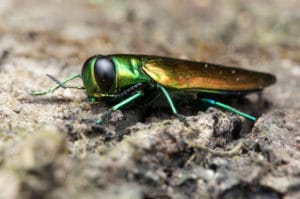
Written by Tony Hahn, Landscape Care Consultant at Swingle
Some of you may have noticed that ash trees are no longer for sale at many nurseries throughout Colorado. The reason is no bigger than a penny, but has killed over 50 million Ash trees across 29 states.
 It is known as Emerald Ash Borer (EAB), and is currently threatening Ash trees in two Colorado communities – Boulder and Longmont. It is not necessarily a matter of if, by when it will spread to neighboring cities and beyond.
It is known as Emerald Ash Borer (EAB), and is currently threatening Ash trees in two Colorado communities – Boulder and Longmont. It is not necessarily a matter of if, by when it will spread to neighboring cities and beyond.
Ash trees, (Fraxinus pennsylvanica and Fraxinus americana) Green and White Ash respectively, were once a popular tree choice because they were easy to establish in our dense Colorado soil, grew quickly, and provided beautiful fall colors.
But since the discovery of Emerald Ash Borer in Boulder County, I am often asked to recommend alternatives to an Ash tree. This is not an altogether easy question to answer.
There are a few factors to consider when deciding on a shade tree for your property. First and foremost the most common we get asked is how long will I have to wait until I can actually enjoy some shade?
Since there is no such thing as the “perfect tree”, we then have to weigh the advantages versus the disadvantages of each by doing our homework. (Or you can ask a professional arborist or nursery worker what they think). Here is what I think.
I do not want a tree that grows fast. Faster growing trees are softer wooded trees, which are prone to snow damage. We live in an area that is subject to heavy, wet snow storms early in the fall and late in the spring. I want a tree that will be resilient to snow storms, yet grow reasonably quick so it won’t take a generation to enjoy some shade.
Luckily, there are trees out there that fit the bill.
However, the exposure (what side of the house/building will it be on) is something we need to determine before planning.
Since well over 90% of landscape plantings are NOT NATIVE to Colorado, doing some research into WHERE the tree is indigenous to is helpful.
Trees, which optimally grow in Colorado, must be from a location that is cold-hardy. It is a fact that most trees, which are “pleasing to the eye”, are the most delicate. Trees with attractive and unique flowers like Eastern Redbud or Magnolia need protection from the intense heat, which occurs on a typical south or west facing exposure.
Many of our trees, with an attractive red or orange fall color, are also trees that cannot tolerate a south or west facing exposure. The best trees for a brutal south or west facing exposure are notoriously not fancy.
These include Hackberry, Honeylocust, Linden, Buckeye, Horsechestnut, Coffeetree, Elm, Silver Maple, Catalpa, Hawthorn, Sycamore, Planetree, Ornamental Pear, and members of the White Oak family (English Oak, Swamp White Oak, Bur Oak).
For less brutal locations like an east or north facing exposure, possibilities include ‘Whitespire’ Birch, Purple and Tri-color Beech, Sugar Maple, Red Maple, Wasatch Maple, Red Oak, Scarlet Oak, ‘Texas Red’ Oak, Norway Maple, Serviceberry, Redbud, Yellowwood, Tulip Poplar, Mountain Ash, Japanese Pagoda-Tree, Hornbeam, Gingko, and Alder.
There are some trees I would not place into consideration…ever! These include any species of Willow, Cottonwood, Russian Olive, Tree-of-Heaven, Sumac, Buckthorn, Chokecherry, Siberian Elm, Boxelder, and Mulberry.
For more information on what to plant on your Colorado property instead of an Ash tree, schedule a free property evaluation.
 Tony Hahn is the “face” of Swingle on 7News, 9News and KHOW-630AM radio and a veteran of the green industry since 1979. Tony is a Landscape Care Consultant with Swingle and a Certified Arborist through the International Society of Arboriculture (ISA).
Tony Hahn is the “face” of Swingle on 7News, 9News and KHOW-630AM radio and a veteran of the green industry since 1979. Tony is a Landscape Care Consultant with Swingle and a Certified Arborist through the International Society of Arboriculture (ISA).